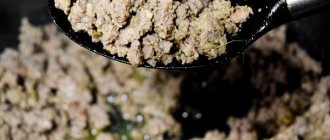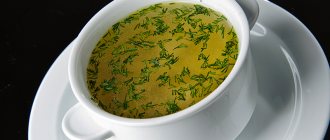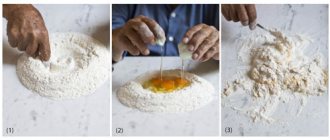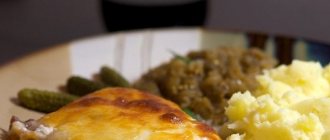Thawing in the refrigerator
The process of defrosting meat on the refrigerator shelf is a subject of constant debate. Most experts are of the opinion that this method is safe.
When the temperature inside the refrigerator is maintained at 4 degrees, the products do not lose their beneficial properties, and pathological processes do not develop inside them (provided the storage periods are observed). The muscle tissue remains elastic, so this type of defrosting will not cause the meat to turn into a mass without shape.
It is forbidden to defrost meat on the door, here the temperature level is higher, this will cause spoilage after 2-3 hours.
Sequence of defrosting meat in the refrigerator:
- remove the original packaging;
- place the product in a container;
- wrap the meat in cling film;
- place on the refrigerator shelf;
- leave inside for a while (each kilogram melts for about 8 hours).
Sometimes incomplete defrosting of the product is allowed, when the temperature inside it is about -4 degrees; this level allows you to cook meat without worrying about the quality of the dish.
When the product is defrosted but not yet ready to cook, wrap it in a waffle towel on top of the package. In this form it can be stored for another 3 days.
Methods and modes of defrosting meat
Various methods are used to defrost meat. Depending on the temperature, defrosting can be slow, accelerated or fast. Coolants can be air, steam-air mixture, water, and various solutions. The air medium has the worst thermophysical properties, followed by the steam-air mixture, and the best are brine and water.
When defrosting slowly in air, the temperature should initially be 0-3 °C, then it is increased to 6-8 °C; at the same time, the relative humidity of the air is 90-95%, the speed of its movement is 0.2-0.3 m/s. At the end of defrosting, the temperature is reduced to 0 °C and the relative humidity to 70%. The duration of thawing beef half-carcasses with this method is 3-5 days, depending on the weight of the carcass and fatness.
Accelerated defrosting in air is carried out at a temperature in the chamber of 16-20 ° C, relative humidity of 90-95% and air speed of 0.2-0.5 m/s for 24-30 hours.
Rapid defrosting is achieved in a steam-air environment at a temperature of 20-25 ° C, relative humidity of 90-95%, and a movement speed of 1-2 m/s for 12-16 hours.
When choosing a defrosting method, it is necessary to take into account that at elevated defrosting temperatures, the activity of tissue enzymes and microflora is activated, which can lead to a sharp deterioration in the quality of meat.
Existing methods for defrosting meat are not perfect. Slow defrosting in air is accompanied by weight loss and can lead to microbial spoilage. However, during subsequent deboning, the loss of meat juice is insignificant. During slow defrosting, a dark crust forms on the surface of the meat; when cut, the color is normal.
Although rapid defrosting speeds up the process, there is a loss of meat juice; during boning and trimming they reach 2%. The surface of the meat is dense and dry.
It is possible to maintain the quality of meat at a sufficiently high speed of air defrosting using the method of showering, as well as tunnel installations with variable processing modes. The meat is defrosted in two or three stages.
During steam-air defrosting, no losses are observed, but during subsequent cutting they reach 5-8%. The meat is discolored and does not store well.
Defrosting meat in a liquid medium can be very effective if you have the packaging in which it was frozen and stored.
Meat is defrosted in special chambers equipped with hanging tracks for placing carcasses and half-carcasses or racks for placing small cuts, blocks and poultry. Cells must be equipped with heating, circulation and air conditioning systems.
Meat blocks, as a rule, are defrosted in air at a temperature of 8-16 ° C, relative air humidity of 90-95% and air speed of 0.5-2 m/s. The duration of defrosting blocks 120 mm thick at the specified environmental parameters does not exceed 20 hours.
The above defrosting methods are based on the transfer of heat to the surface of the product from the external environment through heat exchange.
A promising method is one in which the heat required for defrosting is generated in the volume of the frozen product. Volume defrosting methods are based on the electrical properties of meat. Frozen meat has the properties of weak conductors and dielectrics, so it is placed in an alternating electric field and it heats up like a dielectric. Defrosting occurs as a result of volumetric heating. At the same time, the products are of high quality: there is no shrinkage, lipid oxidation, loss of meat juice, and the bacterial contamination of meat is reduced.
It is advisable to defrost block meat using ultrahigh frequency currents.
Question 3 Purpose and execution of the document “Rejection Journal of Finished Products”
Sample of filling out a reject log of finished products Rejection of products is important The concept of rejection is the carrying out of samples of manufactured products by production and public catering establishments before sale. A qualitative assessment of products is carried out by a locally appointed commission. All conclusions and comments are entered into the finished product rejection log; a sample of the filling can be viewed here. Contents 1 The concept of a rejection log 2 Characteristics of the rejection process 3 Legal nuances 4 Conclusion The concept of a rejection log Based on the Decree of the State Chief Physician of the Sanitary Service of the Russian Federation No. 20, No. 4303, as well as the provisions of SanPiN, mandatory control of finished products is required before selling them to consumers. This is especially strict for meals in preschool and school institutions. The results of product samples are entered into a rejection journal, which consists of pages with columns where the following is recorded: The exact time of preparation (release). Name of product (dish). Date of implementation of the defect control. Conclusions of organoleptic examination and sufficient readiness of the product. Implementation and use decision. Visas of commission members. Addition (in the form of a note). Cover of the magazine The marriage magazine is prepared by filling out the appropriate columns, numbering, visa and seal of the enterprise. The document must be laced and stored with the production manager. You can view a sample of filling out a reject log for finished products here. A sample of filling out a production defect log confirms the enterprise’s intention to carry out quality control. Instead of a specialized commission in the field of catering, the senior cook (pastry chef) is allowed to carry out screening and fill out a magazine of the established form. The employer grants this right to the kitchen worker in accordance with qualifications, professional qualities and the corresponding rank. The cook personally tastes the dishes and records the data on organoleptic indicators in a journal, certifying them with a personal signature. The quality of dishes does not always depend on the professionalism of the chefs. The purchased products, their freshness, compliance with shelf life, recipes, and compliance with technology standards are of great importance. Important! When inspecting catering establishments, Rospotrebnadzor representatives always first ask for a rejection log. Characteristics of the rejection process Inspection of products is carried out by taking a sample or laboratory analysis. So, for example, before serving a dish to the consumer, 15-20 minutes before the food is served, a sample must be taken. Organoleptic indicators are entered into a rejection register and recorded in it, indicating all the necessary requirements. The organoleptic requirements of products include the relationship between appearance and taste. During the grading process, technology and costing are also studied. The product is weighed, attention is paid to consistency, appearance (external and cut), smell, taste, transparency. This applies not only to dishes from the catering department, but also to products of all types, including semi-finished products. When checking, the ratings are given: 5, 4, 3 or 2. An unsatisfactory rating prohibits acceptance of the product, it is removed from production and sales by the rejection commission. When conducting an inspection, there may be a need for laboratory tests, which members of the commission notify by making an entry in the sampling report. Products for laboratory testing are packaged in tightly closed containers, wrapped in paper, tied with twine and sealed. A negative test response is grounds for removing products from sale. This fact must be recorded in the reject log. Product control Control over the quality of food preparation, the release of finished products and the release of semi-finished products can be departmental, administrative and personal. The first includes a special commission created at the enterprise. Personal inspection is carried out directly by the employer himself or by manufacturers directly on site. Administrative control is carried out by the production manager. During the working day, quality control is carried out by foremen. The rejection commission itself includes (Letter of the Public Catering Administration No. 7-3/8-867) in small enterprises: the director and production manager, a senior cook in the team, a health worker. In large industries, the list of persons listed also includes: a process engineer, a laboratory worker, a highly qualified cook or pastry chef, a sanitation station worker (or a member of the production sanitation post). Important! The composition and number of members of the rejection commission is approved by order of the management, including the people's control group, as well as trade unions. Legal nuances Despite the fact that there are no direct regulatory instructions on working with rejection logs in the Rules SP 2.3.6.1079-01, clause 15.1 of these provisions directly states that it is necessary to maintain daily documentation on the preparation and release of finished products, to control the quality of frying fats . These requirements apply to ready-made batches of food, drinks, confectionery, cheese, sausage, dairy and other types of products, as well as semi-finished products. Clause 1 of the joint venture recommends in public catering sampling and evaluation as each portion of products is prepared, produced according to demand and sales (clauses 8.3, 9.1). Recording in the journal must be carried out in accordance with all the rules and signed by authorized persons - the manufacturer and the inspector (Letter of the Ministry of Trade No. 0848). The form of the rejection log is provided for by the standards of NP SRO APSPSZ, as well as SanPiN: 4.1.3049 – 13 (Appendix 8, table 1); 4.5.2409 – 08 (Appendix 10, form 2). The algorithm of action of the Rospotrebnadzor inspection service when conducting rejection commissions is based on Appendix 15 of Rospotrebnadzor Order No. 220. If during the inspection process a product of inadequate quality is revealed, then it is brought to the required state. If this is not possible, then persons who damaged the product and violated manufacturing rules will compensate for material damage from their personal income. Important! Ensuring the quality of manufactured products must be carried out in accordance with strict adherence to technological disciplines and the manufacturing process, technical documents. Conclusion A waste log is an important element of monitoring the products a person consumes. It is necessary to control the process of cooking and semi-finished products in order to protect your health from unnecessary problems.
In each manufacturing enterprise, manufactured products undergo a certain check of compliance with the requirements - technical, operational, as well as the conditions set by the purchasers of this product. Such a procedure is called rejecting finished products and it can be carried out voluntarily on the initiative of the company administration, or mandatory if required by law.
For example, in organizations specializing in the production of precision parts for mechanical engineering, or in food industry enterprises, product rejection is mandatory . The results of its implementation are entered into a special control log, where they are recorded for each batch or item of goods, and based on the final quality assessments, the presence of defects is established or the finished products are sent to the end consumer. Let's learn how to fill out this form.
Steam defrosting
Defrosting using steam is an excellent way to achieve gentle thawing of meat, without disturbing the density of muscle tissue or destroying the structure. This method is best used for small pieces.
The process of using steam looks like this:
- place the pieces on the bottom tray of the multicooker;
- select the steam cooking mode;
- run the program;
- After the product has slightly thawed, transfer it to a higher tray.
Steam can be used in the oven:
- place the pieces in a heat-resistant container;
- place on the oven tray;
- turn on the oven at 35 degrees;
- Monitor the process and turn the meat in a timely manner.
The main disadvantage of this method is the gradual disappearance of moisture, which leads to external drying of the product, with ice remaining inside.
What water is best to defrost meat in?
The use of water as a source of accelerating the process of defrosting meat is allowed. The main thing is to use cold water for this purpose. Thus, the process proceeds as naturally as possible, without having a negative impact on the product.
The use of hot water is allowed occasionally, with a short time interval. When using this method, active proliferation of pathogenic microflora inside the piece occurs.
In cold water
The defrosting process looks like this:
- place the meat product inside a plastic bag;
- pour cold water into a bowl;
- place the bag inside the container, make sure that no water or air gets inside it;
- periodically change the water in the bowl with new water, every half hour.
In hot water
The use of hot water is allowed in emergency cases when the product needs to be separated from the bag (if it has frozen too tightly to it), or to separate whole pieces that have been frozen into a monolith.
Carry out the defrosting process in the same way as with cold water. Just keep the raw materials for the minimum possible time inside a container filled with hot water. If this rule is not followed, microbes will begin to actively multiply inside the product.
In the microwave
A microwave is the most convenient device for defrosting meat products. The main thing is to follow the rules to prevent the appearance of an unpleasant odor and the loss of juiciness in the meat.
The correct process for using a microwave oven:
- Remove packaging from meat.
- Place the product inside a special container and cover it with a lid.
- Turn on the desired mode.
- After 3 minutes, stop the device and turn the meat over.
- Repeat the steps until you achieve your goal (usually takes up to 30 minutes).
If the model is not equipped with a defrosting function, set the power to high, also periodically stop the device and turn the meat over, checking the degree of defrosting.
The advantage of using a microwave oven is the absence of changes in the taste of the finished dish, its structure, and the complete safety of the product for health.
In a microwave oven.
This option should be used extremely rarely, since bacteria in meat spread at the speed of light. And yes, don’t forget that you can’t put meat back in the freezer after microwaving it, it will spoil very quickly and become unfit for consumption. Carefully study the meat thawing function, compare the time and grams. When placing meat in the microwave, do not leave it unattended; turn it every 3 minutes so that it thaws evenly. Drain the secreted liquid as soon as it appears, otherwise it will bake and the meat will begin to cook in it, remaining frozen inside.
In the oven or slow cooker
It is advisable to use an oven if it is electric. A gas oven is characterized by sudden changes in temperature, which is why ice remains inside the meat and a crispy crust forms on the outside.
Defrosting in an electric oven:
- place on the grill, after placing the piece inside a suitable container;
- preheat the oven to 35 degrees;
- periodically unwrap the product in different directions.
If the oven is equipped with a convection function, turn on the mode and place the food in containers on the middle part of the baking sheet. The air movement created by the fan will help defrost the piece.
The multicooker also copes well with the process of defrosting meat. Place the container on the bottom shelf of the device, select the steam cooking mode. After a while, move the bowl to a higher shelf.
Despite the speed of defrosting when using these methods, experts do not recommend their use because they significantly change the taste of the finished dish.
How to Thaw Meat Using Apple Cider Vinegar
Apple cider vinegar can speed up the defrosting process. It is used this way:
- put the product inside a plastic bag;
- immerse in deep container;
- pour a mixture of water and apple cider vinegar inside in a 1:1 ratio;
- after a reaction occurs between ice and vinegar, the thawing process will begin, because a greenhouse effect occurs inside the bag.
The advantage of this method is the complete preservation of the properties and taste of meat after defrosting.
How not to defrost meat
Defrost meat strictly according to established rules, otherwise it will not only lose its taste and external qualities, but may also become hazardous to health.
What not to do:
- Place meat products on central heating radiators.
- Use hot water or an oven to keep frozen meat for a long time.
- Try to defrost the meat as quickly as possible.
- Subject an already thawed product to re-freezing.
- Freezing meat in large pieces will make it difficult to defrost it further and will force unneeded parts to be re-frozen.
- Store for a long time at temperatures above 0 degrees.
Features of defrosting different types of meat
Each type of meat has its own characteristics, therefore the process of defrosting them should take into account these subtleties. This will preserve the taste of the final dish, prevent changes in the structure of the fibers, and prevent the meat from losing its aesthetic appearance.
How to quickly defrost chicken meat
Chicken dishes are prepared only from previously defrosted raw materials. Active defrosting can cause a significant deterioration in the appearance of the chicken.
Instructions for defrosting chicken:
- Peel the carcass from the wrapping paper, place it inside a deep container, and cover with a lid.
- Place it on the refrigerator shelf.
- The average defrosting speed for a small chicken is no more than a day.
If you need to get the product a little earlier, use cold water. As a rule, the carcass becomes suitable for further cooking in about an hour.
How to quickly defrost beef
Proper thawing is very important for beef, it will help keep the steaks looking great and tasting great. Never use hot water for this procedure, and do not leave meat on the table in the room. An oven will not work here either; already at 35 degrees the process of protein denaturation will begin. Because of this, the meat will begin to cook before it defrosts. In this case, active proliferation of bacteria begins, which will jeopardize the safety of the finished dish.
It is better to defrost beef on the bottom shelf of the refrigerator. Pre-wrap the meat in plastic to prevent it from coming into contact with air and foreign odors. Medium-sized steaks (about 2.5 cm) will defrost in about 12 hours.
Thawed beef can be stored for no longer than three days in a refrigerator.
Quickly defrost beef:
- put the meat in a bag;
- Immerse the bag in ice water, previously poured into a deep bowl;
- change the water to cold every 30 minutes, within 2 hours the defrosting process will be completed;
- After defrosting is complete, remove the meat from the packaging and let it breathe for a few minutes, only then begin the cooking process.
How to quickly defrost pork meat
Pork can be used using a variety of methods:
- cold water;
- apple cider vinegar;
- refrigerator.
The use of salt has a good effect, increasing heat transfer, due to which the meat defrosts faster.
Salt defrosting method:
- dilute salt and water in a deep container in the proportion of half a glass per liter;
- remove the packaging from the meat;
- put the meat in salted water.
How to properly defrost turkey meat
Turkey meat is distinguished by its delicate texture, so handle it as carefully as possible and under no circumstances subject it to rapid defrosting.
Turkey defrosting technology:
- put the carcass in a bowl and put it in the refrigerator;
- after 7 hours, remove the carcass;
- pour cold water into the container;
- put the carcass in a bag, lower it into water;
- Change the water every half hour; the defrosting process will take up to three hours.
You cannot store turkey at temperatures above 15 degrees, as pathogenic microflora will actively multiply inside and spoilage processes will begin.
Rapid defrosting in water
One of the simplest and most affordable options to help quickly defrost meat products is to use plain water. This technology is used most often among housewives.
In the process, you should adhere to certain rules, which are as follows:
- before sending a piece of meat under water, it should be placed in a plastic bag so that the structure of the fibers is not disturbed;
- if the product is planned to be defrosted without packaging, then the water should be changed every quarter of an hour, this will reduce the risk of microorganisms multiplying;
- if the liver is defrosted, then additional milk is poured into the water, this will make the offal tender and soft.
There are several technologies; in the first case, defrosting is carried out with hot water. To do this you need to do the following:
- place the frozen piece in an airtight container;
- put it in a saucepan and fill it with hot water, its temperature should vary within 60 degrees;
- leave the meat for 10 minutes, and then put it on a plate.
This method allows you to defrost a product weighing 2 kg in one hour; each kg takes about half an hour. But you need to take into account that the technology promotes the breakdown of protein, and the taste of the prepared dish noticeably deteriorates.
We recommend reading —>>> How to cook pork stew
Defrosting with ice water:
- the piece of meat is wrapped in cling film or placed in a plastic bag;
- place in a deep container and fill with water;
- add ice cubes;
- New ice sheets are added periodically.
You can also quickly defrost meat under running water; just lay it flat over the tap and turn it on so that the liquid flows in a thin stream. This promotes even defrosting.
This method has a number of advantages over others. Firstly, the product remains fresh and does not become dry and tough during subsequent cooking. The piece thaws gradually and evenly, retaining the juice.
How to quickly defrost meat outdoors
Defrosting meat products in the fresh air is not the safest method. Firstly, at temperatures above 15 degrees, bacteria will begin to multiply inside. Secondly, insects that carry dangerous diseases can land on the product.
When you need to defrost meat outdoors, you need to take care of this in advance. While still at home, you should remove the meat from the freezer and place it on the refrigerator shelf. Afterwards, when the meat has thawed by about half, it is placed in a bag. Meat is transported outdoors in a thermal bag, which prevents it from spoiling under the influence of heat.
How the type of freezing affects the thawing of meat, poultry, fish, minced meat
You can quickly defrost meat using different methods, but when choosing them, you must take into account what type of freezing was chosen and the type of product. Minced meat will take the longest time - about 5-6 hours. It takes 2-3 hours for the meat to thaw. The defrosting process is fastest for fish products - about an hour. The speed of thawing is also affected by the way the meat was frozen.
| Type of freezing | Short description |
| Deep | Allows you to preserve almost all useful substances in the product. And this method is considered the most effective. But it cannot be done at home, because it requires special equipment. It is used in poultry farms and factories. The shelf life of deep-frozen products is 3 months. But defrosting it takes a lot of time, so it’s better to take care of this in advance. |
| Quick home | It also retains almost all useful substances. This method is chosen when you need to quickly freeze meat. Modern refrigerators have this freezing mode. Its other name is “product shock therapy.” The advantage is that the speed of defrosting does not differ from the speed of thawing of products frozen in the usual way. |
| Regular home | Suitable only for cases where meat does not need to be stored for a long time. This is due to the fact that airtight packaging was not used for this process. |
The time and method for thawing meat or minced meat depends on the freezing method used. Then the product will retain all the necessary nutrients without losing its taste.
How many times can you defrost meat?
Re-freezing already thawed meat is allowed only if it has been defrosted on the refrigerator shelf and has not thawed completely. There is no particular danger here; the only drawback of such manipulations will be the loss of juiciness and part of the taste of the meat.
A product that has melted in the oven, microwave, cold or hot water should not be re-frozen. During such processes, active reproduction of the pathogenic microflora inside occurs. During repeated defrosting, these processes will begin much earlier, in addition, part of the protein will be destroyed, which will make the finished dish tough, not so nutritious and tasty.
Ways to defrost meat - at home without a microwave
In order to save time, purchases are often made in small wholesale for a week or two, since storing food is not a problem, freezers and refrigerators are capacious, and almost every family has either a chest or a freezer cabinet.
Kinds:
- Slow defrosting is the preferred method, in this case the products do not lose their beneficial qualities. The longer the thawing process, the more tasty and juicy the product will remain before the cooking process. There is an opinion that as a result of delaying time for thawing - this is a bird or a large piece of meat, the reproduction of bacteria begins on thawed surfaces, destroying the structure and properties of the meat product. By the time the inner or middle parts of the piece thaw, its outer part loses its beneficial qualities.
- Operational defrosting saves time to a large extent, but depreciates the quality of the product due to the activation of its enzymes. Accelerated thawing leads to rapid loss of liquid, resulting in a deterioration in the taste of the product. Ice crystals located in frozen meat fibers practically tear them apart when the process accelerates, which provokes a large loss of moisture.
In cases where there is a need for quick cooking, and the food is deep frozen, it is possible to quickly thaw it. There is an opportunity to quickly defrost meat or poultry, and it is not alone:
- in a warm room (this can be room temperature, or the heat of a radiator);
- placing it in water (it can be either cold or hot);
- calling for help from kitchen appliances (electric oven, microwave oven, multicooker, double boiler);
- water bath - when a small saucepan, with a freezer placed in it for thawing, is placed in a larger saucepan with boiling water.
Choosing the one method that is most suitable for you is entirely your decision. Famous chefs are of the opinion that the most acceptable method in such situations is defrosting in water. What is the attractiveness of this method:
- heat exchange in water occurs much faster than in air (this is physics);
- access and regeneration of bacteria on the top of the product is minimized;
- The product retains its taste, remains juicy and soft.










